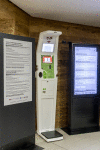A Breathtaking Lift: Sex and Body Mass Index Differences in Cardiopulmonary Response in a Large Cohort of Unselected Subjects with Acute Exposure to High Altitude
- PMID: 34424758
- PMCID: PMC8742268
- DOI: 10.1089/ham.2021.0039
A Breathtaking Lift: Sex and Body Mass Index Differences in Cardiopulmonary Response in a Large Cohort of Unselected Subjects with Acute Exposure to High Altitude
Abstract
Vignati, Carlo, Massimo Mapelli, Benedetta Nusca, Alice Bonomi, Elisabetta Salvioni, Irene Mattavelli, Susanna Sciomer, Andrea Faini, Gianfranco Parati, and Piergiuseppe Agostoni. A breathtaking lift: sex and body mass index differences in cardiopulmonary response in a large cohort of unselected subjects with acute exposure to high altitude. High Alt Med Biol. 22:379-385, 2021. Background: Every year, thousands of people travel to high altitude and experience hypoxemia. At high altitude, the partial pressure of oxygen decreases. The aim of this observational study was to determine if there is a relationship between anthropometric features and basic cardiorespiratory variables, including oxygen saturation (SpO2), heart rate (HR), and blood pressure (BP), following acute exposure to high altitude. Materials and Methods: At the 3,466 m top of a cableway station, we installed an automated system for measuring peripheral SpO2, HR, BP, height, weight, and body mass index (BMI). Results: Between January and October 2020, out of 4,874 volunteers (age 39.9 ± 15.4 years, male 54.4%), 3,267 provided complete data (1,808 cases during winter and 1,459 during summer). SpO2 was 86.8% ± 6.8%. At multivariable analysis, SpO2 was significantly associated with age, sex, season, BMI, and HR but not with BP. We identified 391 (12%) subjects with SpO2 ≤80%: they were older, with a higher BMI and HR but without sex or BP differences. Finally, winter season was associated with greater frequency of SpO2 ≤80% (13.3% vs. 10.3%, p = 0.008). Conclusion: Our data show that high BMI, older age, and male sex were associated with greater degrees of hypoxemia following exposure to high altitude, particularly during the winter.
Keywords: BMI; acute hypoxia; high altitude; sex differences.
Conflict of interest statement
No competing financial interests exist.
Figures



References
-
- Agostoni P, Caldara G, Bussotti M, Revera M, Valentini M, Gregorini F, Faini A, Lombardi C, Bilo G, Giuliano A, Veglia F, Savia G, Modesti PA, Mancia G, and Parati G; HIGHCARE Investigators. (2010). Continuous positive airway pressure increases haemoglobin O2 saturation after acute but not prolonged altitude exposure. Eur Heart J 31:457–463. - PubMed
-
- Agostoni P, Contini M, Magini A, Apostolo A, Cattadori G, Bussotti M, Veglia F, Andreini D, and Palermo P. (2006). Carvedilol reduces exercise-induced hyperventilation: a benefit in normoxia and a problem with hypoxia. Eur J Heart Fail 8:729–735. - PubMed
-
- Agostoni P, Mapelli M, and Vignati C. (2020). A breath of oxygen. L'Everest e i colossi della Terra. Le Montagne Incantate. National Geographic 10:60–65.
-
- Agostoni P, Swenson ER, Bussotti M, Revera M, Meriggi P, Faini A, Lombardi C, Bilo G, Giuliano A, Bonacina D, Modesti PA, Mancia G, and Parati G; HIGHCARE Investigators. (2011). High-altitude exposure of three weeks duration increases lung diffusing capacity in humans. J Appl Physiol (1985) 110:1564–1571. - PubMed
-
- Agostoni P, Swenson ER, Fumagalli R, Salvioni E, Cattadori G, Farina S, Bussotti M, Tamplenizza M, Lombardi C, Bonacina D, Brioschi M, Caravita S, Modesti P, Revera M, Giuliano A, Meriggi P, Faini A, Bilo G, Banfi C, and Parati G. (2013). Acute high-altitude exposure reduces lung diffusion: data from the HIGHCARE Alps project. Respir Physiol Neurobiol 188:223–228. - PubMed
